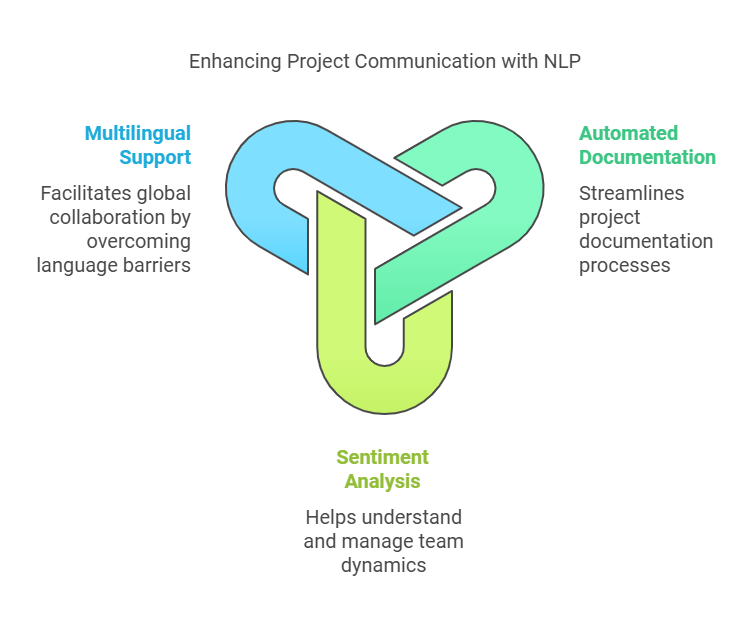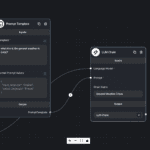How NLP is Breaking Down Language Barriers
In today’s global project landscape, effective communication remains the cornerstone of success. Natural Language Processing (NLP) is emerging as a game-changing technology that’s transforming how project teams communicate, collaborate, and achieve their goals. This comprehensive guide explores how NLP is revolutionizing project communication and why it’s becoming an essential tool for modern project managers.
Understanding NLP in Project Management Context
Natural Language Processing sits at the intersection of linguistics, computer science, and artificial intelligence. In project management, it serves as a powerful tool that helps teams overcome communication barriers and enhance collaboration efficiency.

The Evolution of Project Communication
Traditional project communication relied heavily on:
- Manual documentation and reporting
- Time-consuming meeting minutes
- Complex email threads
- Miscommunication due to language barriers
NLP has transformed these challenges into opportunities for streamlined communication and improved understanding.
Key Applications of NLP in Project Communication
1. Automated Documentation and Reporting
NLP technologies are revolutionizing how teams handle project documentation:
- Automatic generation of meeting summaries
- Real-time transcription of video conferences
- Intelligent categorization of project documents
- Extraction of key action items from communications
2. Sentiment Analysis in Team Communication
Understanding team sentiment helps project managers:
- Identify potential conflicts early
- Gauge team morale
- Assess stakeholder satisfaction
- Make data-driven decisions about team dynamics
3. Multilingual Project Support
NLP breaks down language barriers through:
- Real-time translation of project communications
- Cross-cultural communication enhancement
- Standardization of terminology across languages
- Improved global team collaboration
Implementation Strategies for NLP Tools
Assessment and Planning
Before implementing NLP solutions:
- Evaluate current communication challenges
- Identify specific use cases for NLP
- Assess team readiness for adoption
- Develop an implementation roadmap
Tool Selection Criteria
Choose NLP tools based on:
- Integration capabilities with existing systems
- Language support requirements
- Cost-effectiveness and ROI potential
- User-friendliness and learning curve
Change Management Considerations
Ensure successful adoption through:
- Comprehensive training programs
- Clear communication about benefits
- Regular feedback collection
- Continuous improvement cycles
Best Practices for NLP Implementation
1. Start with High-Impact Areas
Focus initial implementation on:
- Meeting documentation and summaries
- Email management and prioritization
- Team communication analysis
- Document classification and retrieval
2. Ensure Data Privacy and Security
Protect sensitive information by:
- Implementing robust security protocols
- Establishing clear data handling policies
- Regular security audits
- Compliance with privacy regulations
3. Monitor and Optimize Performance
Maintain system effectiveness through:
- Regular performance assessments
- User feedback analysis
- System updates and improvements
- ROI tracking and reporting
Future Trends in NLP for Project Communication
Advanced AI Integration
Expect developments in:
- Emotional intelligence in communication analysis
- Predictive communication patterns
- Advanced context understanding
- Personalized communication assistance
Enhanced Collaboration Features
Future capabilities will include:
- Virtual team facilitation
- Automated conflict resolution suggestions
- Real-time communication optimization
- Enhanced cross-cultural understanding
Measuring Success and ROI
Key Performance Indicators
Track success through:
- Communication efficiency metrics
- Time saved in documentation
- Error reduction rates
- Team satisfaction scores
- Project delivery improvements
ROI Calculation Framework
Consider both quantitative and qualitative factors:
- Time and cost savings
- Improved accuracy rates
- Team productivity gains
- Enhanced stakeholder satisfaction
- Reduced miscommunication incidents
Overcoming Common Challenges
1. Technology Adoption
Address resistance through:
- Clear demonstration of benefits
- Phased implementation approach
- Adequate training and support
- Success story sharing
2. Integration Issues
Manage technical challenges by:
- Careful vendor selection
- Thorough testing procedures
- Robust support systems
- Regular maintenance schedules
Conclusion
NLP is transforming project communication from a potential bottleneck into a strategic advantage. By implementing NLP solutions thoughtfully and following best practices, organizations can significantly improve their project communication effectiveness and team collaboration.
Call to Action
Ready to transform your project communication with NLP? Start by assessing your current communication challenges and exploring available NLP solutions. Connect with experts and join professional communities to stay updated on the latest developments in this rapidly evolving field.





Leave a Reply